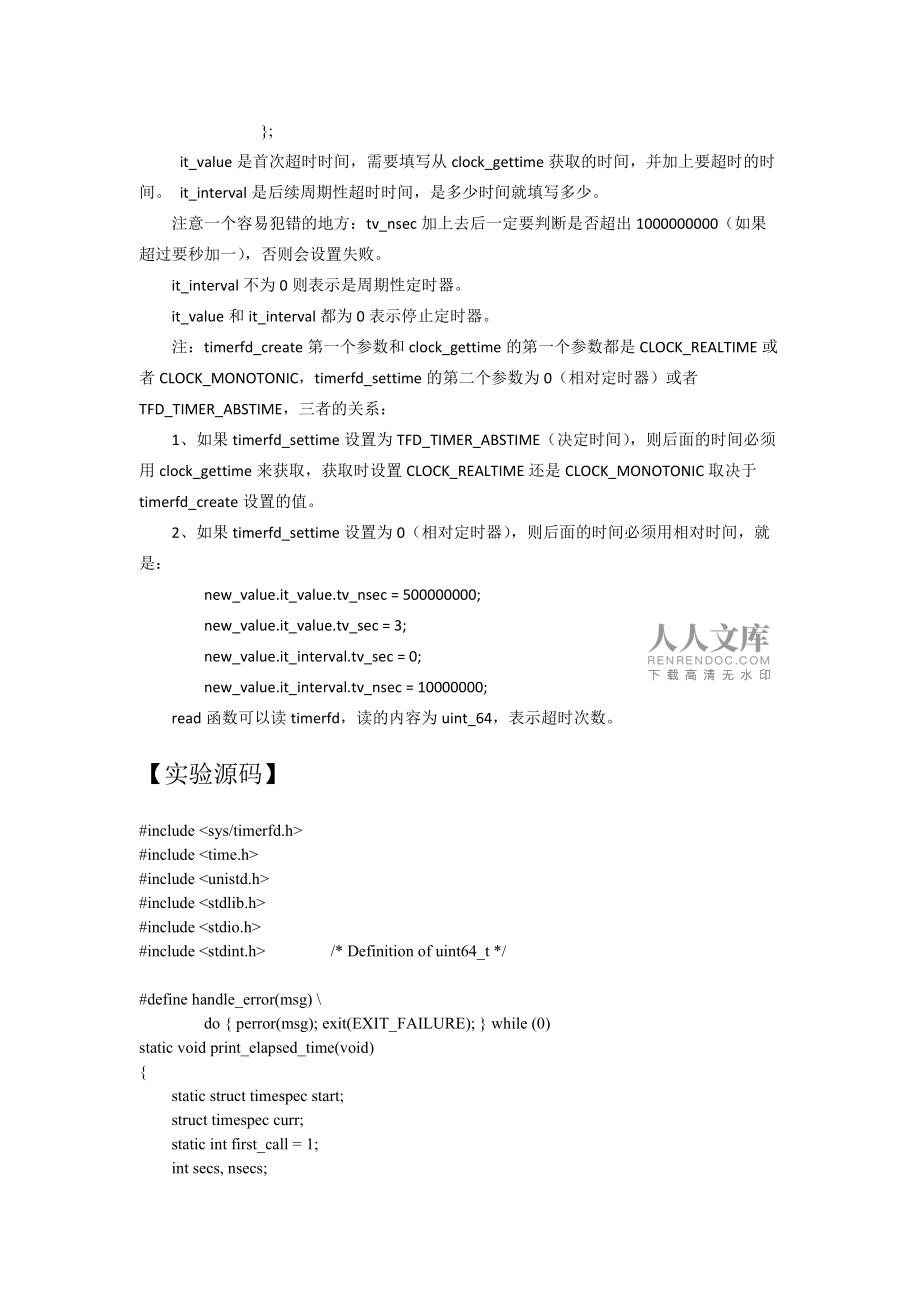



下载本文档
版权说明:本文档由用户提供并上传,收益归属内容提供方,若内容存在侵权,请进行举报或认领
文档简介
1、实验5 定时器【实验原理】timerfd是Linux为用户程序提供的一个定时器接口。这个接口基于文件描述符,通过文件描述符的可读事件进行超时通知,所以能够被用于select/poll的应用场景。timerfd是linux内核2.6.25版本中加入的接口。timerfd、eventfd、signalfd配合epoll使用,可以构造出一个零轮询的程序,但程序没有处理的事件时,程序是被阻塞的。这样的话在某些移动设备上程序更省电。clock_gettime函数可以获取系统时钟,精确到纳秒。需要在编译时指定库:-lrt。可以获取两种类型事件:CLOCK_REALTIME:相对时间,从1970.1.1到目
2、前的时间。更改系统时间会更改获取的值。也就是,它以系统时间为坐标。CLOCK_MONOTONIC:与CLOCK_REALTIME相反,它是以绝对时间为准,获取的时间为系统重启到现在的时间,更改系统时间对齐没有影响。timerfd_create:生成一个定时器对象,返回与之关联的文件描述符。接收两个入参,一个是clockid,填写CLOCK_REALTIME或者CLOCK_MONOTONIC,参数意义同上。第二个可以传递控制标志:TFD_NONBLOCK(非阻塞),TFD_CLOEXEC(同O_CLOEXEC)注:timerfd的进度要比usleep要高。timerfd_settime:能够启动
3、和停止定时器;可以设置第二个参数:flags,0表示是相对定时器,TFD_TIMER_ABSTIME表示是绝对定时器。第三个参数设置超时时间,如果为0则表示停止定时器。定时器设置超时方法:1、设置超时时间是需要调用clock_gettime获取当前时间,如果是绝对定时器,那么需要获取CLOCK_REALTIME,在加上要超时的时间。如果是相对定时器,要获取CLOCK_MONOTONIC时间。2、数据结构: struct timespec time_t tv_sec; /* Seconds */ long tv_nsec; /* Nanoseconds */ ; struct itimerspe
4、c struct timespec it_interval; /* Interval for periodic timer */ struct timespec it_value; /* Initial expiration */ ; it_value是首次超时时间,需要填写从clock_gettime获取的时间,并加上要超时的时间。 it_interval是后续周期性超时时间,是多少时间就填写多少。注意一个容易犯错的地方:tv_nsec加上去后一定要判断是否超出1000000000(如果超过要秒加一),否则会设置失败。it_interval不为0则表示是周期性定时器。it_value和it_
5、interval都为0表示停止定时器。注:timerfd_create第一个参数和clock_gettime的第一个参数都是CLOCK_REALTIME或者CLOCK_MONOTONIC,timerfd_settime的第二个参数为0(相对定时器)或者TFD_TIMER_ABSTIME,三者的关系:1、如果timerfd_settime设置为TFD_TIMER_ABSTIME(决定时间),则后面的时间必须用clock_gettime来获取,获取时设置CLOCK_REALTIME还是CLOCK_MONOTONIC取决于timerfd_create设置的值。2、如果timerfd_settime设
6、置为0(相对定时器),则后面的时间必须用相对时间,就是: new_value.it_value.tv_nsec = 500000000; new_value.it_value.tv_sec = 3; new_value.it_interval.tv_sec = 0; new_value.it_interval.tv_nsec = 10000000;read函数可以读timerfd,读的内容为uint_64,表示超时次数。【实验源码】#include #include #include #include #include #include /* Definition of uint64_t */
7、#define handle_error(msg) do perror(msg); exit(EXIT_FAILURE); while (0)static void print_elapsed_time(void) static struct timespec start; struct timespec curr; static int first_call = 1; int secs, nsecs; if (first_call) first_call = 0; if (clock_gettime(CLOCK_MONOTONIC, &start) = -1) handle_error(cl
8、ock_gettime); if (clock_gettime(CLOCK_MONOTONIC, &curr) = -1) handle_error(clock_gettime); secs = curr.tv_sec - start.tv_sec; nsecs = curr.tv_nsec - start.tv_nsec; if (nsecs 0) secs-; nsecs += 1000000000; printf(%d.%03d: , secs, (nsecs + 500000) / 1000000);Int main(int argc, char *argv) struct itime
9、rspec new_value; int max_exp, fd; struct timespec now; uint64_t exp, tot_exp; ssize_t s; if (argc != 2) & (argc != 4) fprintf(stderr, %s init-secs interval-secs max-expn, argv0); exit(EXIT_FAILURE); if (clock_gettime(CLOCK_REALTIME, &now) = -1) handle_error(clock_gettime); /* Create a CLOCK_REALTIME
10、 absolute timer with initial expiration and interval as specified in command line */ new_value.it_value.tv_sec = now.tv_sec + atoi(argv1); new_value.it_value.tv_nsec = now.tv_nsec; if (argc = 2) new_value.it_interval.tv_sec = 0; max_exp = 1; else new_value.it_interval.tv_sec = atoi(argv2); max_exp =
11、 atoi(argv3); new_value.it_interval.tv_nsec = 0; fd = timerfd_create(CLOCK_REALTIME, 0); if (fd = -1) handle_error(timerfd_create); if (timerfd_settime(fd, TFD_TIMER_ABSTIME, &new_value, NULL) = -1) handle_error(timerfd_settime); print_elapsed_time(); printf(timer startedn); for (tot_exp = 0; tot_exp max_exp;) s = read(fd, &exp, sizeof(uint64_t); if (s != sizeof
温馨提示
- 1. 本站所有资源如无特殊说明,都需要本地电脑安装OFFICE2007和PDF阅读器。图纸软件为CAD,CAXA,PROE,UG,SolidWorks等.压缩文件请下载最新的WinRAR软件解压。
- 2. 本站的文档不包含任何第三方提供的附件图纸等,如果需要附件,请联系上传者。文件的所有权益归上传用户所有。
- 3. 本站RAR压缩包中若带图纸,网页内容里面会有图纸预览,若没有图纸预览就没有图纸。
- 4. 未经权益所有人同意不得将文件中的内容挪作商业或盈利用途。
- 5. 人人文库网仅提供信息存储空间,仅对用户上传内容的表现方式做保护处理,对用户上传分享的文档内容本身不做任何修改或编辑,并不能对任何下载内容负责。
- 6. 下载文件中如有侵权或不适当内容,请与我们联系,我们立即纠正。
- 7. 本站不保证下载资源的准确性、安全性和完整性, 同时也不承担用户因使用这些下载资源对自己和他人造成任何形式的伤害或损失。
最新文档
- 一体化教学常用方法课件
- 教学课件介绍
- 散打儿童教学课件
- 歌唱课教学课件
- 【宿迁】2025年江苏宿迁市宿豫区卫生健康局下属事业单位第二批招聘工作人员14人笔试历年典型考题及考点剖析附带答案详解
- 【徐州】2025年江苏徐州市卫生健康委直属事业单位招聘144人笔试历年典型考题及考点剖析附带答案详解
- 英语语音教学课件设计
- 易错点08 违法犯罪-备战2021年中考道德与法治一轮复习易错题
- 春节果干蜜饯活动方案
- 映山红景区活动方案
- 2025年全国统一高考英语试卷(全国一卷)含答案
- 2025年内蒙古高考物理试卷(含答案)
- 北京玉渊潭中学初一新生分班(摸底)数学模拟考试(含答案)【6套试卷】
- 广东省深圳市宝安区2023-2024学年五年级下学期期末英语试题
- MOOC 国际商务-暨南大学 中国大学慕课答案
- 高处作业审批表
- 急救医学模拟中心建设方案
- 三维激光扫描技术与应用实例-PPT课件
- 农用地评价方法
- 14S501-1 球墨铸铁单层井盖及踏步施工
- (新知杯)2017-2011上海市初中数学竞赛试卷

评论
0/150
提交评论